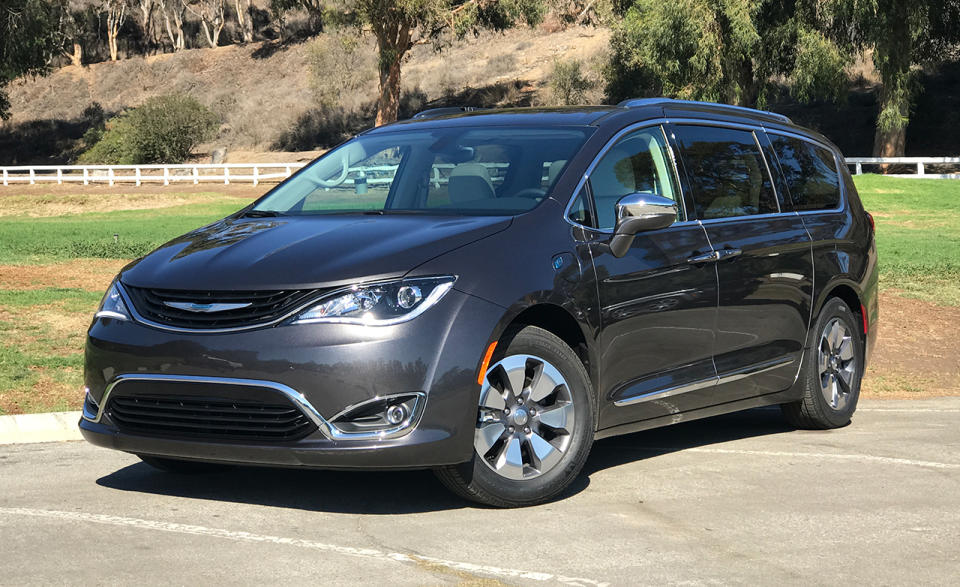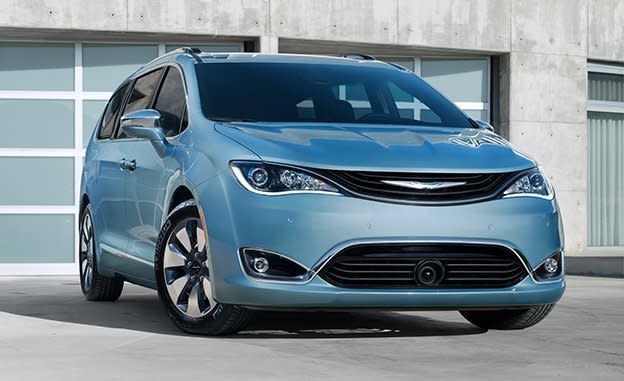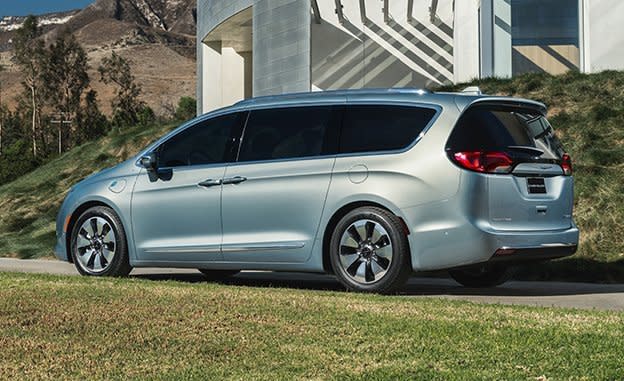2017 Chrysler Pacifica Plug-In Hybrid

When the first Chrysler minivans hit the market in 1984, they revolutionized family transportation. The front-wheel-drive vans offered carlike ride and handling in a compact shape that preserved a lot of the space and practicality of larger vans and station wagons. It was a risky proposition at the time as Chrysler needed a mass-market success to save itself from bankruptcy. The decision to roll the dice has since gone down in history as one that not only saved the company but dramatically altered the automotive landscape, with minivans becoming the go-to family vehicle until the more recent rise of the SUV.
Now Chrysler finds itself in an arguably more stable financial position. (Again, arguably.) The brand is making another attempt at modernizing family transport by introducing a plug-in-hybrid variant of its all-new Pacifica minivan. Not only will it be the first of its kind offered on American shores when it hits dealer lots in early 2017, but it also retains most of the space and practicality of the nonhybrid model.

Under the hood is the familiar 3.6-liter V-6 from the standard Pacifica, but it has been revised for hybrid duty with new pistons, camshafts, and valves, and it adopts the Atkinson combustion cycle for improved fuel efficiency. Under the second-row floor (where the Stow ’n Go seats can be stashed) is a 16.0-kWh lithium-ion battery pack that Chrysler estimates will provide up to 30 miles of pure-electric driving before the gasoline engine is needed; two hours on a 240-volt connection should net a full charge (14 hours is required on 120 volts). All of this is par for the course when it comes to plug-in-hybrid powertrains, but it’s the Pacifica hybrid’s eFlite electrically variable transmission that sets it apart.
Many hybrid drive systems use two AC motor/generators for propulsion, to recapture energy during coasting and braking and to regulate the engine’s drive ratio, and the new eFlite transaxle is no different. It was developed in-house by Fiat Chrysler engineers and uses a planetary gearset and a one-way clutch to direct torque from the two electric motors and the engine to the differential. Chrysler says the system is more compact than rival setups and boasts greater efficiency. Brand officials are being coy about it, but the system’s compact size should make it easier to adapt the powertrain to a variety of future products within the FCA family. For the Pacifica hybrid, Chrysler is estimating city fuel-economy ratings as high as 80 MPGe.

The Pacifica hybrid will be offered in Premium and Platinum trim levels. We were able to sample a Platinum model on a route up the Pacific Coast Highway to Malibu and through the mountains near Santa Monica. Southern California is a fitting place to launch the hybrid minivan, not just because its name evokes a longing for warm ocean waters, but because of the area’s battle with air pollution and crippling traffic. Plug-in-hybrid vehicles such as the Pacifica hybrid qualify for special access to California’s high-occupancy-vehicle (HOV) highway lanes even when carrying only the driver, making them particularly attractive to commuters.
In the city, the Pacifica hybrid moves around its estimated 5000 pounds with authority, with the electric drivetrain doing the bulk of the heavy lifting. Pulling into heavy midday traffic on Santa Monica Boulevard was no problem at all. The estimated 30-mile electric-only range seems fairly accurate; we made it that far, give or take a mile or two, before the electrons ran out. On undulating mountain roads, the hybrid powertrain felt capable and never overtaxed, even on long uphill grades. Regenerating as we coasted back down, we were able to coax seven additional miles of electric-only cruising for use on our trip home. After a little less than 100 miles, the Pacifica’s onboard trip computer estimated that we had averaged 30.6 mpg—not bad, especially considering the standard Pacifica’s EPA combined rating of 22 mpg. (The EPA ratings for the hybrid aren’t yet available.)
The hybrid’s ride and handling are much the same as that of the gas-powered Pacifica. Chrysler engineers increased spring rates to accommodate the hybrid’s claimed 613-pound weight gain, and it appears to have done the trick, as the hybrid’s smooth ride and confident body control were similar to the standard model’s. As with the nonhybrid, steering is light and vague on-center, but this minivan is easy to maneuver around town and requires few corrections to keep tracking straight on the highway.

Not everything is as well sorted as in the regular model, though. The brake pedal feels limp and nonlinear underfoot, making it difficult to apply the right amount of braking power. And the gasoline engine, while smooth and surprisingly quiet when cruising, sends an unrefined shiver into the cabin when kicking on during heavy throttle takeoffs. We imagine that these issues eventually will fade into the background for owners, but they did take us a portion of the day to acclimate to and could be improved.
Only subtle changes were made to the exterior styling, such as the wave-textured front grille, model-specific 18-inch aluminum wheels, and teal-accented Chrysler logos. The Pacifica hybrid’s interior will be familiar to those who have seen the regular van; it has the same soft-touch plastics, plethora of USB ports, thoughtful placement of cupholders and storage bins, and Chrysler’s easy-to-use Uconnect touchscreen infotainment system. A driver-facing 7.0-inch digital instrument cluster is standard and features hybrid-specific information such as operating mode, total range, and eco-friendly driving tips.
Opting for the hybrid model does come with one big compromise, which we mentioned earlier: Chrysler’s signature Stow ’n Go second-row seats aren’t available since the underfloor seat-storage cavities are filled with battery cells. While not ideal, this does at least rectify one of our main gripes about the standard Pacifica—second-row seat comfort. Since the middle seats no longer need to fold compactly to fit under the floor, they boast more padding and are far more comfortable.

The Premium trim, starting at $43,090, comes with goodies such as heated leather seats for first-row passengers, remote start, three-zone automatic climate control, second-row captain’s chairs, and a power liftgate. Platinum models will command a $46,090 sticker price and add ventilated seats for front-row passengers, a heated two-tone steering wheel, in-dash navigation, and hands-free sliding side doors. A single-screen, overhead DVD player ($895) is the Premium model’s only option. Platinum models come standard with a dual-touchscreen rear-seat entertainment system with integrated games for the kids and offer an optional panoramic sunroof for $1795. The Chrysler Pacifica hybrid will qualify for a $7500 federal tax credit and may qualify for additional state and local incentives, which bring the total cost down significantly and, in the case of the Premium trim, within just $100 of a gasoline-powered Pacifica Touring-L with similar equipment.
While the hybrid powertrain isn’t a revelation, it’s a satisfying addition to the Pacifica lineup—and it could spur rivals such as Honda (which already has a hybrid minivan on sale in Japan) and Toyota to offer hybrid minivans in the United States. Just as it did with the original minivans of the 1980s, Chrysler is plowing fresh ground, and the car-buying public stands to benefit.
Specifications >
VEHICLE TYPE: front-engine, front-wheel-drive, 7-passenger, 4-door van
BASE PRICES: Premium, $43,090;
Platinum, $46,090
ENGINE TYPE: DOHC 24-valve Atkinson-cycle 3.6-liter V-6, 2 permanent-magnet AC motors; combined output, 260 hp; 16.0-kWh lithium-ion battery pack
TRANSMISSION: continuously variable automatic
DIMENSIONS:
Wheelbase: 121.6 in
Length: 203.8 in
Width: 79.6 in Height: 69.9 in
Passenger volume: 159-164 cu ft
Cargo volume: 32 cu ft
Curb weight (C/D est): 5000 lb
PERFORMANCE (C/D EST):
Zero to 60 mph: 8.2 sec
Zero to 100 mph: 22.0 sec
Standing ¼-mile: 16.8 sec
Top speed: 110 mph
FUEL ECONOMY (C/D EST):
EPA city/highway: 25/33 mpg
EPA gas+electricity combined driving: 75 MPGe

 Yahoo Autos
Yahoo Autos 